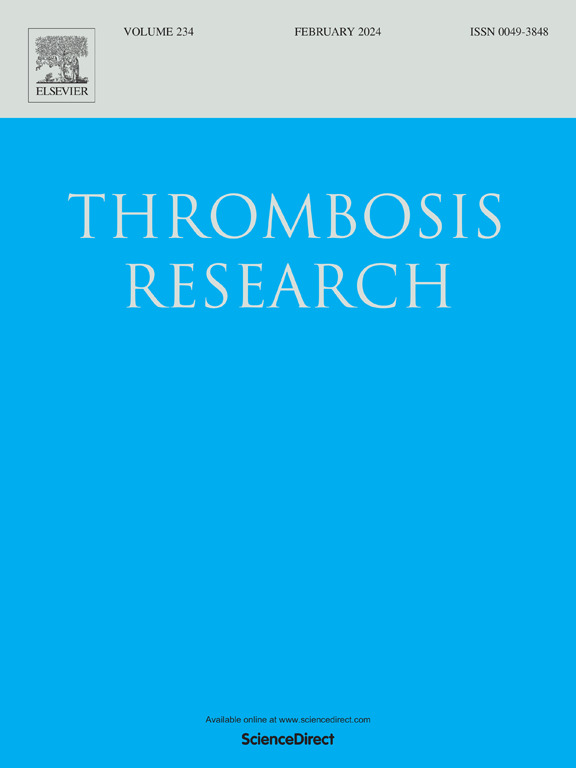利伐沙班与华法林治疗小儿不同心脏部位心内血栓形成的比较:抗凝方法的早期经验和治疗结果
IF 3.4
3区 医学
Q1 HEMATOLOGY
引用次数: 0
摘要
目的比较利伐沙班与华法林治疗小儿心内血栓形成(ICT)的效果。方法在2020-24年,我们招募了18例[0.7 (0.3-12,Q1-Q3)岁,67%男性]连续ICT儿科患者(<;在2020-22年接受华法林治疗(n = 9, 0.1 mg/Kg/天),在2023-24年接受利伐沙班治疗(n = 9,剂量基于患者体重)。超声心动图怀疑ICT,并通过心脏计算机断层扫描(CCT)或磁共振(CMR)成像证实。所有参与者在利伐沙班实施前接受依诺肝素治疗7天。重复CCT/CMR以确认ICT分辨率。右心房血栓患者占9/18(50%),右/左心室血栓患者占5/18(28%),左心附件血栓患者占3/18(17%),左心附件血栓患者占1/18(5%)。结果与华法林相比,利伐沙班治疗的持续时间更短(Log-rank P = 0.020);华法林vs利伐沙班:9.67±3.6 vs 6.6±2.2周(P = 0.0040)。服用利伐沙班后,所有血栓均消失,并在CCT/CMR成像中得到证实;根据BASIC出血评估量表,治疗期间无大出血事件记录。仅有少量出血记录。华法林组出现消化道出血n = 6/9(67%),肉眼血尿n = 2/9,利伐沙班组出现牙龈出血3例。随访6个月后,超声心动图检查未发现或怀疑复发。结论:在儿童ICT患者中,无论血栓部位如何,利伐沙班在血栓消退方面似乎有效本文章由计算机程序翻译,如有差异,请以英文原文为准。

Comparison of rivaroxaban with warfarin for intracardiac thrombosis in the pediatric population at different cardiac sites: Early experience of anticoagulation approach and treatment outcomes
Aims
To compare the rivaroxaban treatment with warfarin for intracardiac thrombi resolution in pediatric patients diagnosed with intracardiac thrombosis (ICT).
Methods
In 2020–24, we enrolled 18 [0.7 (0.3–12, Q1-Q3) years-old, 67 % males] consecutive ICT pediatric patients (< 16 years old) treated in 2020–22 with warfarin (n = 9, 0.1 mg/Kg/day) and in 2023–24 with rivaroxaban (n = 9, dosage based on patient's body weight). ICT was suspected by echocardiography and confirmed with cardiac computed tomography (CCT) or magnetic resonance (CMR) imaging. All the participants were treated with enoxaparin for 7 days before the rivaroxaban implementation. CCT/CMR was repeated to confirm ICT resolution. N = 9/18 (50 %) patients presented with right atrial thrombosis, n = 5/18 (28 %) and n = 3/18 (17 %) with right/left ventricular thrombi, respectively, and n = 1/18 (5 %) with left atrial appendage thrombus.
Results
Compared with warfarin, treatment with rivaroxaban had a shorter duration (Log-rank P = 0.020); warfarin vs. rivaroxaban: 9.67 ± 3.6 vs. 6.6 ± 2.2 weeks (P = 0.0040). After rivaroxaban, all the thromboses were resolved and confirmed at the CCT/CMR imaging; no major bleeding event was documented during the treatment based on the BASIC bleeding assessment scale. Only minor bleedings were documented. In details: warfarin experienced n = 6/9 (67 %) gastrointestinal bleedings and n = 2/9 macroscopic hematuria, while 3 gingival bleedings were documented in the rivaroxaban group. After a follow-up period of 6 months, no recurrences were detected/suspected at the echocardiography evaluation.
Conclusions
Among pediatric patients with ICT, irrespective of the thrombosis site, rivaroxaban seemed effective in thrombus resolution.
ClinicalTrials.gov ID
NCT06371170
求助全文
通过发布文献求助,成功后即可免费获取论文全文。
去求助
来源期刊

Thrombosis research
医学-外周血管病
CiteScore
14.60
自引率
4.00%
发文量
364
审稿时长
31 days
期刊介绍:
Thrombosis Research is an international journal dedicated to the swift dissemination of new information on thrombosis, hemostasis, and vascular biology, aimed at advancing both science and clinical care. The journal publishes peer-reviewed original research, reviews, editorials, opinions, and critiques, covering both basic and clinical studies. Priority is given to research that promises novel approaches in the diagnosis, therapy, prognosis, and prevention of thrombotic and hemorrhagic diseases.
 求助内容:
求助内容: 应助结果提醒方式:
应助结果提醒方式:


